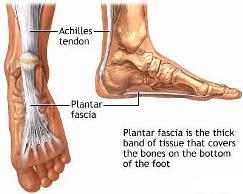As a quick diversion from our series on medical misdiagnosis, I just couldn’t help but throw in another basketball blog in honor of the start of the season. I know I’m a little late in the game already, but I’ve been traveling so much this past month and haven’t had a minute, till now, to dedicate to my favorite subject.
The topic of this week’s blog is plantar fasciitis, which has been called the Achilles Heal of the NBA. Two of the most well known Lakers to have suffered this condition are Kobe Bryant and Shaquille O’Neal. Ron Artest played thru this problem in both feet early in 2010. Tim Duncan of the Spurs and Tyreke Evan of the Sacramento Kings are currently competing on damaged feet, for now, although who knows if and when the situation might progress to the point where they will need to sit out a game or two. The Celtics Rajon Rando recently received the diagnosis as well. Last season, the starting center for the Chicago Bulls, Joakin Noah, was pulled out for 18 games due to this condition. And this is but a small sample of the past and present afflicted. And yes, normal people are also affected by plantar fasciitis (not just the golden boys and girls of professional athletics). A November 4 article by the American Association of Orthopaedic Surgeons states that 2 million Americans seek treatment for this condition each year. That could be you.
So what exactly is this ailment that takes down so many of our best and brightest? Let me explain about the anatomy of the foot and it will become clear. Plantar fasciitis is named for a sickness in the area of the plantar group of muscles; the largest muscles in the foot. This broad band of fibrous tissue attaches at the heel bone, runs along the whole bottom of the foot and then attaches to the base of each toe. The plantar’s role in the movement and stability of the foot is unparalleled and its power is nearly equal to the jaw per square inch of force.
 Although the most common symptom of plantar fasciitis is a stabbing pain in the heel, the “sickness” of the plantar could cover anything in this broad range of the foot. It’s a bit of a general diagnosis, sort of like saying you have a Rotator cuff injury. The rotator cuff is such a prevalent muscle in the shoulder that any injury in that area is going to involve the rotator cuff. So any injury to the muscles of the bottom part of the foot seems to be, in medical lingo, termed plantar fascia. It has become a catchall diagnosis for any deep problem in this area.
Although the most common symptom of plantar fasciitis is a stabbing pain in the heel, the “sickness” of the plantar could cover anything in this broad range of the foot. It’s a bit of a general diagnosis, sort of like saying you have a Rotator cuff injury. The rotator cuff is such a prevalent muscle in the shoulder that any injury in that area is going to involve the rotator cuff. So any injury to the muscles of the bottom part of the foot seems to be, in medical lingo, termed plantar fascia. It has become a catchall diagnosis for any deep problem in this area.
For athletes the plantar area can get pretty tight as it is the body’s first line of defense from impact forces associated with the running and jumping that the pros do so much of so well . When the muscle gets tight there can be considerable pain depending upon what it compresses. If it compresses on a nerve that’s one thing, or if the joints compress on each other because of all that tension, that’s another. There are 27 bones in the foot, which means there are a lot of joints in a very small area and a lot of opportunity for compression. Whatever the specific root of the pain, however, the treatment for Plantar fasciitis can be quite simple. Once you loosen up the muscles of the bottom of the foot, magically you don’t have the pain. You don’t have the compression on the joints, which causes the swelling that causes the pain. You don’t have the aggravation of the tendon being pulled by the tight muscle.
One of the best forms of therapy I know for releasing this area is standing on a tennis ball. (CAUTION: This exercise is NOT recommended if the plantar is damaged due to high impact trauma.) I know it sounds odd, but it works. The trick is to keep your leg straight, keep your hand on a door or a desk for support and step on the tennis ball with just enough pressure to feel a little discomfort on the bottom of the foot. That is the key – to really get your weight on top of the ball – and to keep that degree of pressure on the whole time while you slowly roll the ball under your foot so that it comes into contact with as many parts of the bottom of the foot as possible. If you do this exercise every day, for 5 -15 minutes you will get results. Check out this youtube video for a simple demonstration. As with most structural ailments, the sooner you catch and treat the problem, the quicker it can be resolved.
Good luck Lakers. Keep your plantar on the tennis ball and feel better forever.
